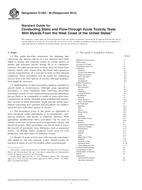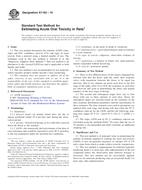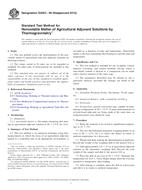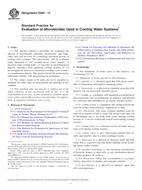Potřebujeme váš souhlas k využití jednotlivých dat, aby se vám mimo jiné mohly ukazovat informace týkající se vašich zájmů. Souhlas udělíte kliknutím na tlačítko „OK“.
ASTM E1463-92(2012)
Standard Guide for Conducting Static and Flow-Through Acute Toxicity Tests With Mysids From the West Coast of the United States (Withdrawn 2021)
Automaticky přeložený název:
Standardní Guide pro dirigování statické a průtokové Akutní toxicita testy s Mysids ze západního pobřeží Spojených států
NORMA vydána dne 1.12.2012
Informace o normě:
Označení normy: ASTM E1463-92(2012)
Poznámka: NEPLATNÁ
Datum vydání normy: 1.12.2012
Kód zboží: NS-41843
Počet stran: 23
Přibližná hmotnost: 69 g (0.15 liber)
Země: Americká technická norma
Kategorie: Technické normy ASTM
Kategorie - podobné normy:
Anotace textu normy ASTM E1463-92(2012) :
Keywords:
acute toxicity, aquatic, culture techniques, Holmesimysis costata, invertebrates, mysids, Neomysis mercedis , ICS Number Code 77.120.70 (Cadmium, cobalt and their alloys)
Doplňující informace
| Significance and Use | ||||||||||||||||||||||||||||||||||||||||||||||||||||||||||||||||||||||||||||||||||||||||||||||||||||||||||||||||||||
|
5.1 Mysids are an important component of both the pelagic and epibenthic community. They are preyed upon by many species of fish, birds, and larger invertebrate species, and they are predators of smaller crustaceans and larval stages of invertebrates. In some cases, they feed upon algae. Mysids are sensitive to both organic and inorganic toxicants 5.2 An acute toxicity test is conducted to obtain information concerning the immediate effects of a short-term exposure to a test material on a test organism under specified experimental conditions. An acute toxicity test provides data on the short-term effects that are useful for comparisons to other species but does not provide information on delayed effects. 5.3 Results of acute toxicity tests can be used to predict acute effects likely to occur on aquatic organisms in field conditions except that mysids might avoid exposure when possible. 5.4 Results of acute toxicity tests might be used to compare the acute sensitivities of different species and the acute toxicities of different test materials, and to study the effects of various environmental factors on results of such tests. 5.5 Results of acute toxicity tests might be an important consideration when assessing the hazards of materials to aquatic organisms (see Guide E1023) or when deriving water quality criteria for aquatic organisms (2). 5.6 Results of acute toxicity tests might be useful for studying biological availability of, and structure activity relationships between test materials. 5.7 Results of acute toxicity tests will depend, in part, on the temperature, quality of the food, condition of test organisms, test procedures, and other factors. |
||||||||||||||||||||||||||||||||||||||||||||||||||||||||||||||||||||||||||||||||||||||||||||||||||||||||||||||||||||
| 1. Scope | ||||||||||||||||||||||||||||||||||||||||||||||||||||||||||||||||||||||||||||||||||||||||||||||||||||||||||||||||||||
|
1.1 This guide describes procedures for obtaining data concerning the adverse effects of a test material (not food) added to marine and estuarine waters on certain species of marine and estuarine mysids during 96 h of continuous exposure. Juvenile mysids used in these tests are taken from cultures shortly after release from the brood and exposed to varying concentrations of a toxicant in static or flow-through conditions. These procedures will be useful for conducting toxicity tests with other species of mysids, although modifications might be necessary. 1.2 Modifications of these procedures might be justified by special needs or circumstances. Although using appropriate procedures is more important than following prescribed procedures, results of tests conducted using unusual procedures are not likely to be comparable to results of many other tests. Comparisons of results obtained using modified and unmodified versions of these procedures might provide useful information concerning new concepts and procedures for conducting acute tests with other species of mysids. 1.3 The procedures given in this guide are applicable to most chemicals, either individually or in formulations, commercial products, and known or unknown mixtures. With appropriate modifications these procedures can be used to conduct acute tests on factors such as temperature, salinity, and dissolved oxygen. These procedures can also be used to assess the toxicity of potentially toxic discharges such as municipal wastes, oil drilling fluids, produced water from oil well production, and other types of industrial wastes. 1.4 Results of acute toxicity tests with toxicants experimentally added to salt and estuarine waters should usually be reported in terms of a LC50 (median lethal concentration). 1.5 This guide is arranged as follows:
1.6 The values stated in SI units are to be regarded as the standard. 1.7 This standard does not
purport to address all of the safety concerns, if any, associated
with its use. It is the responsibility of the user of this standard
to establish appropriate safety and health practices and determine
the applicability of regulatory limitations prior to use.
Standard Practice for Using Brine Shrimp
Nauplii as Food for Test Animals in Aquatic Toxicology Standard Terminology Relating to
Biological Effects and Environmental Fate Standard Guide for Assessing the Hazard
of a Material to Aquatic Organisms and Their Uses Standard Guide for Conducting Life-Cycle
Toxicity Tests with Saltwater Mysids (Includes all amendments and
changes 1/27/2023). Standard Guide for Conducting Acute
Toxicity Tests on Aqueous Ambient Samples and Effluents with
Fishes, Macroinvertebrates, and Amphibians Standard Guide for Conducting Acute
Toxicity Tests on Test Materials with Fishes, Macroinvertebrates,
and Amphibians (Includes all amendments and changes 2/22/2023). IEEE/ASTM SI 10 American National Standard for Use of the
International System of Units (SI): The Modern Metric System |
Podobné normy:
Historická
1.11.2010
Historická
1.10.2012
Historická
1.10.2012
Historická
1.4.2013
Odebírejte informace o nově vydaných normách ZDARMA:
Chcete pravidelně odebírat informace o nově vycházejících normách z celého světa a to zcela zdarma?
Přihlašte se k odběru. Vše je velice jednoduché a absolutně ZDARMA.
Na výběr máte vydavatele z celého světa.



 ASTM E1163-10
ASTM E1163-10 ASTM E2043-99(2012)..
ASTM E2043-99(2012).. ASTM E2044-99(2012)..
ASTM E2044-99(2012).. ASTM E645-13
ASTM E645-13
 Cookies
Cookies
